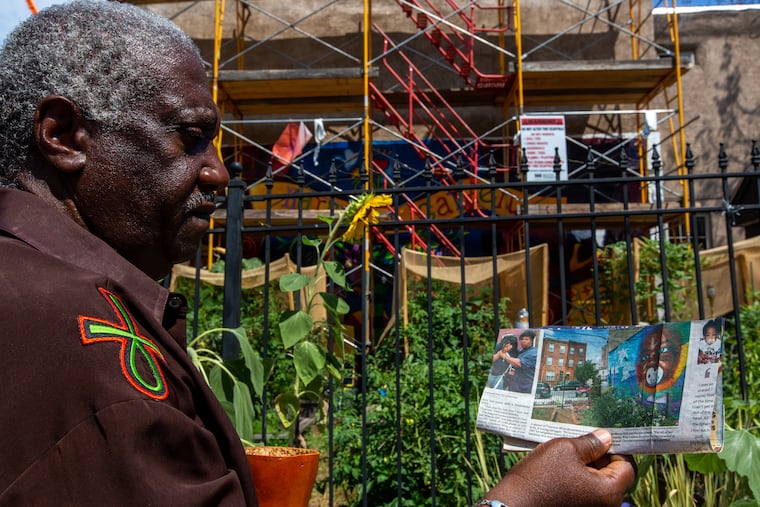Keeper of Philadelphia girl’s memory says new mural masks the painful past | Helen Ubiñas
“A little black girl erased in life and then again, in death.”

He did not choose this role, steward of a dead girl’s memory.
The girl, Charnae Wise, died in the Harper Street rowhouse in 1997 when she was just 5. Starved to death by her drug-addicted mother, 12 pounds of her skeletal remains found under mounds of garbage, her siblings scattered among other homes.
And then six years later, Ancestor Gold Sky and his family moved into the Fairmount house where Charnae was murdered, and the musician and spiritual reader fell into the part.
Regularly he’d answer unannounced knocks on his door, siblings of Charnae who came to remember and pay tribute to a little girl they still grieve.
The tragedy made headlines as one of the most horrific cases of child abuse in city history. One child was dead, and seven children would grow into haunted adults, some of whom could not help but drift toward Sky’s door.
He and his wife would comfort them. That was their mother’s story, they told them. Not theirs. Sometimes, Ancestor would walk them to the corner of 30th and Harper to a peaceful memorial garden and giant mural that honored the little girl, an image of her sucking a pacifier drawn from the only photo retrievable from the house.
But time passed, and new neighbors replaced old ones as the neighborhood became more desirable, the mural fading along with a history that not everyone wanted to remember.
Then one day, Charnae was gone, her likeness erased by the broad brushstrokes from a new mural in progress.
“I thought they were going to freshen her up, not get rid of her,” Sky recalled thinking when he passed by.
There had been meetings, where residents requested a new mural from Mural Arts, discussed and ultimately agreed on a design. But by the time Sky took notice, it seemed to him too late.
"She was gone,” Sky said. “A little black girl erased in life and then again, in death.” The intense fireplug of a man nearly seethes when he says that.
As recently as last month, the design was still being debated. Longtime residents sat in a blooming garden as the sun set and brought up Charnae’s likeness. People talked of wanting to be respectful of the past while honoring the present. Everyone wanted it to signal hope.
A compromise was reached. The mural would now bear a banner that read “The Charnae Wise Memorial Garden.” A framed photo of the girl would be placed in the garden, perhaps in the children’s area. Yes, that seemed right to neighbor Joyce Hill, an original member of Charnae’s memorial steering committee.
But Jane Golden, executive director for Mural Arts Philadelphia, was still uneasy.
Public art is a balancing act between a community’s desires and an artist’s vision; no one knows that better than the woman whose organization is responsible for thousands of murals in the city. What resonates with one person may turn another off. What means something for one community in one moment in time might mean less, or nothing, or even turn off newcomers.
“Public art is successful when the community is happy and everyone feels heard and respected,” she said.
That’s why she had worried when her program was approached about redoing the mural created all those years ago. Mural Arts would proceed only if everyone was on board, and she thought they were when neighbors said they wanted a mural that would capture the spirit of the baby in an uplifting and inspiring way. The artist on the project had lived in the neighborhood.
After Golden and I talked of lingering concerns from the neighbor most connected to the little girl’s memory, more compromises emerged.
Charnae’s likeness would be returned to the mural in some way and also be included in a sign connected to the fence, Golden promised.
Charnae would not be erased, or forgotten. “Tragedy is something to learn from, not wipe away,” Sky said.
Whatever design ultimately made its way on the wall, Sky is sure of only one thing that had worried him from the start: There would eventually be another knock on his door.
And he, as always, would answer.